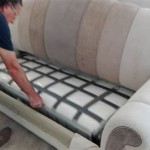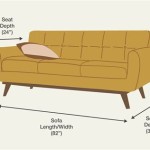Can I Get My Leather Sofa Recovered? Exploring the Possibilities and Considerations
Leather sofas are often considered a significant investment, prized for their durability, aesthetic appeal, and comfort. However, over time, even the highest quality leather can show signs of wear and tear. Scratches, stains, fading, cracks, and general discoloration can diminish the sofa's appearance and overall value. Rather than replacing the entire sofa, many owners explore the possibility of having it recovered. Determining whether a leather sofa can be recovered involves a comprehensive assessment of various factors, including the sofa's construction, the condition of the frame, the type of leather, and the availability of skilled professionals.
Recovering a leather sofa refers to the process of replacing the existing leather upholstery with new material. This is a more extensive undertaking than simply repairing minor damage or cleaning the leather. It requires removing the old leather, assessing the underlying structure, and precisely fitting and securing the new leather. The decision to recover a leather sofa is often driven by a desire to restore its original beauty, update its style, or extend its lifespan. Understanding the complexities of the process is crucial for making an informed decision.
Key Point 1: Assessing the Feasibility of Leather Sofa Recovery
The feasibility of recovering a leather sofa hinges on several key factors, the most significant being the sofa's overall structural integrity. Before considering any reupholstering work, a thorough inspection of the frame, springs, and padding is essential. A sturdy frame is paramount; if the frame is weak, damaged, or prone to further deterioration, the investment in new leather may not be worthwhile. A weak foundation will undermine the aesthetics and longevity of the recovered sofa.
The condition of the springs and padding also plays a crucial role. Sagging springs or flattened padding can significantly impact the comfort and appearance of the sofa, even with new leather upholstery. If these components are in poor condition, they should be repaired or replaced before the new leather is installed. This may involve tightening or replacing springs, adding new padding, or re-stuffing cushions.
The type of leather used on the existing sofa also influences the recovery process. Different types of leather have varying degrees of durability and flexibility, which can affect how well they can be removed and replaced. Some leathers are more prone to tearing or stretching during removal, making the process more challenging. The availability of a suitable replacement leather that matches the desired aesthetic and performance characteristics is also a critical consideration.
Furthermore, the complexity of the sofa's design affects the labor involved and, consequently, the overall cost. Sofas with intricate detailing, tufting, or multiple cushions require more time and skill to recover than simpler designs. These design elements often necessitate specialized techniques and patterns to ensure a proper fit and finish. A detailed assessment of the sofa's construction will help determine the level of expertise required for the recovery process.
Key Point 2: Understanding the Recovery Process and Associated Costs
The process of recovering a leather sofa typically involves several stages. First, the old leather upholstery is carefully removed. This step is often more complex than it appears, as the leather is usually attached to the frame with staples, tacks, or adhesive. Removing the old leather without damaging the frame or underlying structure requires skill and precision. This step can also reveal hidden damage or wear that needs to be addressed.
Once the old leather is removed, the frame, springs, and padding are inspected and repaired as needed. Any structural weaknesses or damage must be addressed to ensure the sofa's stability and longevity. This may involve reinforcing the frame, replacing damaged springs, or adding new padding to worn areas.
Next, the new leather is cut and sewn to fit the sofa. This requires precise measurements and pattern making to ensure a snug and accurate fit. The leather is typically cut from large hides, and the pattern must be carefully planned to minimize waste and ensure that the grain and color are consistent across the entire sofa. The seams must be strong and durable to withstand the stresses of everyday use.
Finally, the new leather is attached to the frame, using techniques similar to those used to install the original upholstery. This may involve stapling, tacking, or gluing the leather to the frame. The leather must be stretched and smoothed to eliminate wrinkles and ensure a professional finish. The cushions are then re-stuffed and covered with new leather.
The cost of recovering a leather sofa can vary widely, depending on several factors. These include the size and complexity of the sofa, the type and quality of the leather used, the labor costs in the area, and the extent of any necessary repairs to the frame, springs, or padding. In general, recovering a leather sofa is more expensive than recovering a fabric sofa, due to the higher cost of leather and the greater skill required to work with it. Obtaining quotes from multiple upholstery professionals is advisable to get a clear understanding of the potential costs involved.
Key Point 3: Selecting the Right Professional and Leather
Choosing a skilled and experienced upholstery professional is crucial for a successful leather sofa recovery. Look for professionals with a proven track record of working with leather and a portfolio of completed projects that demonstrate their expertise. Check online reviews and ask for references to gauge their reputation and customer satisfaction. A reputable professional will be able to assess the sofa's condition, provide an accurate estimate, and offer guidance on selecting the right leather.
Selecting the right type of leather is also essential. There are various types of leather available, each with its own unique characteristics and properties. Full-grain leather is the highest quality and most durable type of leather, but it is also the most expensive. Top-grain leather is a slightly less expensive option that still offers good durability and appearance. Split-grain leather is the least expensive type of leather, but it is also the least durable and most prone to cracking and peeling.
Consider the color and texture of the leather when making your selection. Choose a color that complements the existing décor and a texture that feels comfortable and appealing. It is also important to consider the maintenance requirements of the leather. Some types of leather require regular conditioning to prevent drying and cracking, while others are more resistant to stains and spills. A knowledgeable upholstery professional can provide guidance on selecting the right leather for your needs and lifestyle.
Beyond the type of leather, consider the specific finish and treatment applied to the leather. Aniline leather, for example, is dyed with soluble dyes that do not conceal the natural grain, resulting in a soft and luxurious feel but also increased sensitivity to staining. Semi-aniline leathers have a light protective coating, providing some stain resistance while retaining much of the natural feel. Pigmented leathers have a more durable surface treatment and are generally more resistant to staining and fading, making them suitable for high-traffic areas. Understanding these differences is essential to choosing a leather that aligns with both aesthetic preferences and practical considerations.
Ultimately, deciding whether to recover a leather sofa is a personal one that depends on a variety of factors. Careful consideration of the sofa's condition, the recovery process, the associated costs, and the available options for leather and professional services will lead to a solution aligning with individual needs and financial constraints.

Recover Your Sofa From Leather To Fabric Stunning Transformation And A Lot Er Than New Rescot Upholstery

Leather Sofa Recovery All Over Scotland Rescot Upholstery

Leather Sofa Repadding The Fast And Affordable Way To Give New Life Your Rescot Upholstery

Leather Sofa Recovery Rescot Upholstery

Cost To Reupholster A Couch Save By Recovering We Can Fix That

Leather Furniture Repair Couch Chair Restoration

Leather Upholstery Furniture Sofa Chairs Couches Ottomans Replace And Recover New Restuffing Sagging Broken Down Foam

Bringing Furniture Back To Life With This Sofa Reupholstery

Change A Bonded Leather Sofa To Fabric Rescot Upholstery

Best Leather Dye For Couches Colors Restoration Supplies








